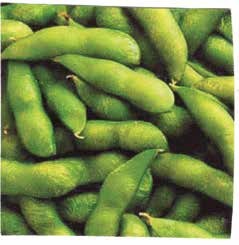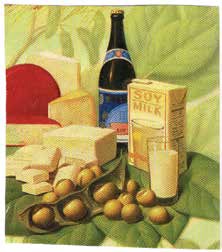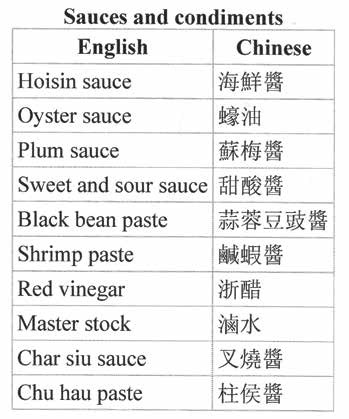
| What is Flavor and Fortune? |
| How do I subscribe? |
| How do I get past issues? |
| How do I advertise? |
| How do I contact the editor? |
Read 13012949 times
Connect me to:
| Home |
| Articles |
| Book reviews |
| Letters to the Editor |
| Newmans News and Notes |
| Recipes |
| Restaurant reviews |
| Article Index (all years, slow) |
| List of Article Years |
| Article Index (2025) |
| Article Index (last 2 years) |
| Things others say |
| Related Links |
| Log In... |
| Authors |
| Categories & Topics |
Soy: As Beans, Sauce, Paste, and Sprouts
| by Jacqueline M. Newman |
Chinese Food History
Summer Volume: 2019 Issue: 26(2) pages: 15 to 20
This ‘King of Condiments’ as the Chinese call soy sauce, has been popular in China for centuries. Loved there as soy and in other sauces and pastes, it is made from sprouted beans. The Chinese word for soy is shu, and has been for generations. That very word was found on four ancient bronze vessels, each with a touch of its remains, from before the 15th century BCE. These containers were carbon-dated, and these words are the earliest record of them, ever.

Called shi there and later in early texts, the remains show the beans partially decomposed by a special mold. They predate any soy sauce and many other soy foods. This sauce is, with the correct ingredients, cheap and easy to make, and widely used throughout China and most of the rest of Asia. It can be made from black or green beans and has a pleasing winy aroma and flavor. The beans are usually rinsed before use, and best chopped a little or crushed or mashed. After that and mixing them with a mold, a little Chinese rice wine, garlic, and ginger, and sometimes a few small pieces of tangerine peel, the process is complete.
Stored for long periods of time, sealed in ceramic crocks or glass jars, after opening and tasting, one finds the sauce thick or thin, and tasty. Always best stored in spotless containers and kept away from light and heat, this sauce has no determined shelf life, can probably be kept indefinitely if without a seasoning such as chili peppers.

In very early days, people and animals looking healthier than others had probably eaten many a heated soy bean in many a way. However, they probably did not know that these beans made them look that way. Nor did they know the beans did return nutrients to the soil they grew in. Scientists now know both and that when they are used in agriculture and industry or consumed by people, if the beans are cooked or heated before use, they are a very healthy ingredient.
They can be sold as sweet bean sauce, yellow bean sauce, garlic or chili bean sauce, or similar items, and can be but do not need to be used to make black bean or another bean sauce with or without garlic and/or chili sauce, or made into an X-O sauce.
In English, the words for these beans can be written as ‘soy beans’ or ‘soybeans’ and we now know they contain substances not readily digestible unless heated or cooked. After doing so, they have a beany aroma and taste, are rich in protein and many individual amino acids, and can contain lots of soy oil, if not removed early in the process. Few people know they can be and are used to make glue for torpedo boats, foam for fire-extinguishers, K-rations for the military, many a margarine, and many other uses.
Originating in China’s Liaoning Province where they grew wild, they grow better in China’s North than in its South, once were Manchuria’s most important oil and ground bean export, particularly from the 1910s through the 1920s, and before that were written about in the Book of Master Mo (circa 400 BCE), also fed to young ponies so they grew better than those who did not eat them, and had other uses, too.
The Chinese have fermented these beans into sauces for a very long time, and by the time of China’s final dynasty, soy sauce eclipsed all other sauces as the core of China’s flavorings. Today, the Fujian Province is regarded as the home of the best soy sauce be it made from whole or ground beans. They season meat dishes most frequently, and as a whole bean or a ground bean sauce, they are the base of many traditional condiments served with Peking Duck.
Now people know the Chinese word shu is for soy beans or soy sauce. It is no longer a new word. We know that because of those four ancient bronze vessels; from at least the early Zhou period (1045 - 256 BCE), unearthed recently with very little left in them, that word was written on their exteriors. Once touted by an Emperor in 1024 BCE, and mentioned in seven poems in the Shi Jing (The Book of Odes) around the 11th to the 7th Centuries BCE, this current Chinese staple is made with beans botanically known as Glycine max. They mature in seventy-five to eighty days, grow three or more feet tall, and though called beans, are hairy seeds that grow in three-bean clusters, have lots of protein, carbohydrate, fibre, oil, vitamins, and minerals in them.
The Chinese also make them into soy milk and soy curds called doufu; the Japanese call these curds tempeh, and they and other Asians use lots of them and have for a couple of thousand years. Most ferment them with an Aspergillus orzae mold, make dozens of products with them in warm dark places, and ferment and mature most of them into adored sauces and pastes.

In the Analects of Confucius, (475 BCE), beans for soy sauce, were documented and called one of China’s five staple grains. Black, green, or white, they were used long before 2700 BCE, and said to be one of the seven essentials of daily life. The others are firewood, rice, cooking oil, salt, vinegar, and tea. Soybeans are unique among oil seeds and they also have lots of high quality protein.
Medical scientists report those eating many of them and products made with them have less coronary heart disease, fewer breast cancers, less osteoporosis; less diabetes, improved glucose tolerance, and better insulin response than those who do not. They also have less renal disease and less diarrhea and if only eating two servings a day, have reduced levels of cholesterol if eaten at a main meal; and people’s risk of coronary heart disease is twenty-five percent less than among those not having eaten any soy beans.
Fermented or not, these beans are used in Chinese soup stocks and are valuable for dairy-sensitive people. If they are used in hoisin sauce, it will be richer and healthier than a similar sauce made with other beans, and it will taste better when vinegar and sugar are added. The Chinese know this and use lots of both.
In 2000 CE, H. T. Huang, an important Chinese food researcher, did write a poem about soy bean knowledge. In its second line he wrote, “In the seventh month we boil mallows and soybeans” and in its seventh stanza says “cultivated grains grouped with paddy rice, hemp seed, soybeans, and wheat.....(are) staple grains of ancient China that produce good yields even in poor years”.
Recent archeological finds say the beans in soy sauce were also found in pottery jars at the Number 1 Tomb at Manwangdui where they were written on bamboo slips and found there as necessities. This is from the early Han Dynasty (202 BCE to 9 CE).
Soy Sauce, has been a staple in China for thousands of years, and widely used in many Chinese dishes. The best is naturally brewed from fermented beans and superior to soy sauce made other ways. Brewing requires many steps, the first uses wheat heated and mixed with an Aspergillus mold. The second incubates soy beans under controlled temperature and humidity. They break their protein bonds into individual amino acids. The are fermented developing color, aroma, and complex flavor and can take six months to two years. The next step presses, pasteurizes, and bottles their liquid. Soy sauce not brewed needs chemicals, synthetics, hydrolyzed vegetable protein, caramel coloring, corn or another syrup, salt, and more.
Chinese soy sauces can be purchased dark, light, and/ or flavored, darker ones are usually fermented longer. They are best for long cooking; lighter ones, often called ‘thin,’ are best to flavor and season delicate foods or be part of a dipping sauce.
Chinese soy sauces can be fermented for thirty days without heat, have less alcohol, and fewer lactic acids. Double Black Soy Sauce is darker and heavier, adds more color and strength to dishes that use it. Dark soy sauces are often called ‘superior.’ Those called ‘lite’ can have forty percent less sodium than regular or dark soy sauces. ‘Mushroom Soy Sauce’ is a Cantonese specialty with added mushroom flavor. Made with dark soy sauce and straw mushrooms, it has a sweeter taste. Some brands add some sugar when manufacturing them.
Most soy sauces were developed some thousands of years ago by fermenting soybeans for at least thirty days with salt and a ferment. Those kept longer taste better and are healthier. When buying fermented soy beans to make your own sauce or paste, we prefer those in cardboard containers with a yellow label because they were never mixed with another grain, can include yeast, and are fermented longer. Americans use lots of soy sauce and only a few soy pastes. The only data I found was that they used forty million gallons of soy sauce in 1998, most as a flavoring agent or for color, and/or to change physical substrates, and make them healthier.

Soy Pastes, can be sweet and mild or piquant if made with chili paste. Years ago, made this way, these pastes were not used as food items but as a treatment for joints, muscles, and knees. We know that because that was written in a Shen Nong Ben Cao edition circa 200 CE. No longer used those ways, soy pastes are now mostly used to flavor foods, cooked with a fan, zhou or a cai dish.
Guangzhou also known as Canton, is the capital of the Guangdong Province, and in China’s southern region. They serve many royal foods such as bird’s nest dishes. Their cooking and its early philosophy includes that every food has natural tastes and textures and they need enhancing.
In this province, typical meals include lots of rice, many vegetables, and foods of the sea or poultry or meat or both made in ultra-fancy ways. Most meats, are marinated with soy sauce to draw out their moisture and starch to seal it in. Many use a little sugar to bring out flavors, and many are with fermented black beans and garlic added as they have for centuries; some even prepared in fancy kitchens.
Creative ingredients and cooking techniques no longer fancy do make all foods taste better. The Cantonese make jokes about this saying that everything tastes better with legs except tables and chairs, everything also tastes better with wings except airplanes. However, it is no joke that if you eat just two of their snack foods known as ‘dim sum’ every day that were popular in 1850, it will take more than a year to taste them all. It is also no joke that a local expression is to marry or be born in Suzhou, visit Hangzhou, eat in Guangzhou, and die in Luzhou. Why these cities? In Suzhou are beautiful women, Hangzhou is itself beautiful, Guangzhou has great food, and Luzhou great wood for one’s coffin.
Almost every Chinatown was settled by people from Guangzhou, many serving super Southern Chinese food. Most Chinese no matter where they are from, do appreciate their light fresh foods, cooked with techniques including steaming and stir-frying.
Southern Chinese came to the US early in the 18th century, three that were written about were seamen who stayed for a year, but not by choice. They landed in Baltimore on a ship called the Pallas, its captain left immediately after unloading and stranded them there. Before and certainly after that, many Chinese landed in San Francisco. Some left to open food stalls and restaurants there and elsewhere, sold Chinese food to other Chinese, and were appreciated.
Guangdong dishes can feature foods from Guangzhou, Chaozhou, Dongjiang, and other Eastern areas. Diverse, they are always fresh, tender, crisp, velvety, lightly flavored, and more intense in Winter and Spring than other seasons. Guangdong, one of China’s oldest cities, is a famous seaport. Its cooking uses less oil, maintains original tastes, makes lightly-flavored dishes, prepares vegetables lightly, serves clear soups and a great number of other dishes at every meal. There are some five thousand different ones, eight hundred different snack foods, and many others; what is not to like.
Roast Suckling Pig, has a long history and many love this dish first mentioned in the Book of Rites written more than two thousand years ago. It is still loved and popular, often served at Imperial Banquets and at fantastic restaurants such as the Pan Xi. A Mushroom Soup is featured below from there, as are others after it.
Soy Sprouts are made in dark humid places sprouting easily from soy beans or mung beans. Both are best washed before using in hot or cold dishes. The Chinese call bean sprouts huang dou ya or dou ya, and those made with mung beans are called lu dou. They like both, and those from mung beans are more popular than those from soybeans. They like them added to many stir-fry dishes for crispness, are also used in soups, egg rolls and spring rolls, and in many other dishes. Bean sprouts can be longer, fatter, and thicker than mung bean sprouts, maybe that is why.
Overall, not all soy bean use is appreciated; if the beans are not heated or cooked, they can be indigestible. Western cuisines rarely use them other than in soy sauce, though other uses of pastes are increasing worldwide. Chinese sauces are mostly called jiangs, and probably the most fermented products used worldwide. They have a mold ferment and have since Neolithic times. It can be a mold, yeast, or bacterial ferment such as those used to make wines. Fermentation preserves perishable foods and protects them from re-infection; and can stimulate the appetite. If you want to learn more about them and all soy foods, read the History of Soybeans and Soy Foods (2014); it is available from the Soyinfo Center; PO Box 234, Lafayette CA 94549 or contact William Shurtleff at info@soyinfocenter.com or fax him at (925) 283-9091.
| Soy Beans, Doufu, and Mustard Greens |
|---|
1 Tablespoon vegetable oil
1. Heat a wok or fry pan, add ginger and stir-fry for
one minute, then add the soy beans and
stir-fry another minute.
|
| Spiced Whole Soybean Pods |
|---|
1 pound fresh soy bean pods, strings and ends removed
Put soy beans, five-spice powder, salt, and the peppercorns in a two-quart pot, and simmer them for twelve minutes, then drain, discard the cheesecloth packet, and chill in the refrigerator for half an hour or more; then serve in a small bowl. |
| Pan Xi Mushroom Soup |
|---|
1½ teaspoons dried broken dong gu mushroom pieces, soaked until soft in one cup warm water, drain and save it
1. Drain mushrooms of course, mix them with chopped
fresh ginger and scallions, salt, and granulated sugar,
and some hot superior soup, reserved mushroom
water, the Shao Xing rice wine, pepper, sesame oil,
a cornstarch mixture, and the chicken fat, and a little
crab roe.
|
The recipes below were not from that talk, but from many different places, a few from Shurtleff sources.
| Homemade X-O Sauce |
|---|
5 dried scallops (also called conpoy) steamed with one cup of water for one hour, then shredded
1. After steaming the conpoy, do save its liquid and
check that it is torn into the thinnest strands possible.
|
| Guizhou Sprouts |
|---|
½ pound fresh soy bean sprouts, tails discarded
1. Simmer the sprouts for two minutes, then drain.
|
| Black Bean Sauce with Garlic |
|---|
3 Tablespoons fermented black beans
1. Mix fermented beans with half cup hot water and
crush the beans using the side of a cleaver.
|
| Water Chestnuts and Other Beans |
|---|
½ cup vegetable oil
1. Heat fry pan, add oil, then fry the shallots until crisp,
drain them, and leave half the oil in the wok or fry pan.
|
| Pork with Bean Sprouts |
|---|
1 Tablespoon vegetable oil, divided
1. Heat a wok or fry pan, add half the oil, and stir-fry the
garlic for one minute, then add the pork, soy sauce, and
cornstarch, and stir-fry for two minutes and remove to
a strainer sitting on a bowl.
|
| Shrimp and Soy Bean Balls |
|---|
3 Tablespoons dry cloud ear fungi, soaked for half hour in boiling water, then drained
1. Soak cloud ear fungi in boiling water for half an hour,
then bring to the boil for one minute, drain them, and
coarsely chop them.
|

Copyright © 1994-2025 by ISACC, all rights reserved
Address
3 Jefferson Ferry Drive
S. Setauket NY 11720